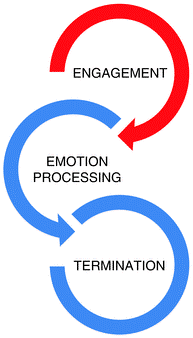Introduction
Brief Psychodynamic Therapy (BPT) is a special kind of treatment that helps people quickly with their mind problems. It’s different from other types and offers faster results in less time. In today’s fast life, where people face many problems, it becomes more important to help with mental health. When we face problems like worry, sadness and past hurts as well as troubles with others, BPT is a helpful treatment. It understands how complicated life can be but also helps make people better faster and change in good ways.
Brief Psychodynamic Therapy takes the main ideas of old-style psychodynamic therapy and makes it quicker without losing deep meaning or how useful it is.
Several studies in the American Journal of Psychiatry state that Brief Psychodynamic Therapy has shown an impressive 50% reduction rate in symptoms among people dealing with generalized anxiety disorder. This concrete proof highlights the efficacy of BPT in promptly relieving symptoms and promoting mental health. This article interestingly talks about Brief Psychodynamic Therapy. It explains its details to show why it’s a good option for those who want fast and deep healing.
What is Brief Psychodynamic Therapy?
Brief Psychodynamic Therapy is a proven, short-term type of counseling that looks at and deals with the main reasons behind feeling upset. Unlike old-fashioned long therapy, BPT helps people make important changes quickly. Usually, this method usually covers 16 meetings. It is a helpful and quick choice for people who want fast help with mental problems.
The American Psychological Association reports that Brief Psychodynamic Therapy is particularly useful in treating specific issues such as phobias, panic disorders, and post-traumatic stress disorder (PTSD).

How does Brief Psychodynamic Therapy work?
In Brief Psychodynamic Therapy, therapists work with their clients to look into hidden problems and unresolved feelings. This can help understand symptoms better. By showing these hidden problems, people can learn more deeply about their thoughts and feelings. This helps them to fix things quickly and make symptoms better.
BPT is a descendant of psychodynamic psychotherapy which developed through the pioneering works of Sigmund Freud in the latter nineteenth and early twentieth centuries. Psychodynamic approaches began with Freud’s investigation of the unconscious mind and its effect on action.
BPT assumes that the underlying basis of many psychological symptoms lies within unresolved conflicts and repressed emotions hidden deep in one’s unconscious mind. This therapy usually involves investigations into early life experiences, relationships and patterns of behavior to realize and understand the origins of current symptoms. It involves psychodynamic theories that suggest adult emotional well-being is significantly impacted by early experiences.
It could employ techniques such as free association, dream analysis and investigation into transference and countertransference dynamics to reveal hidden thoughts or emotions.
A randomized controlled trial conducted by the British Journal of Psychiatry found that BPT was associated with significant improvements in interpersonal functioning and overall well-being.

Key Components and Distinctive Features of Brief Psychodynamic Therapy
This therapeutic modality consists of the different constituents that help individuals to go through a procedure designed for fast problem resolution and self-awareness enhancement. The following key components illuminate the fundamental aspects of Brief Psychodynamic Therapy:
1. Time-Limited Focus
- Most of the time, Brief Psychodynamic Therapy lasts for about 12 to 20 sessions. It gives a plan that makes therapy clear and easy to follow.
- This time limit pushes people to work closely with their therapist and solve big problems quickly.
2. Uncovering Unconscious Conflict
- Brief Psychodynamic Therapy investigates inside our minds, trying to find feelings we’re keeping hidden, problems not solved and things that keep happening over and again. These are stopping us from growing mentally in a healthy way.
- By learning about these hidden parts, people can know more and understand better their actions, connections with others and feelings.
3. Therapeutic Relationship
- In Brief Psychodynamic Therapy, the helpful connection between a client and therapist is marked by understanding each other’s feelings. They also have trust in one another and work together as a team.
- This strong connection creates a safe and helpful space, making it easy to look into hard feelings or events.
4. Insight-Oriented Approach
- Brief Psychodynamic Therapy is meant to help people understand their feelings and know why they feel bad.
- By talking and thinking about their actions, people understand themselves better. This helps to make permanent changes in what they think, feel and do.
5. Focus on Defense Mechanisms
- Brief Psychodynamic Therapy understands the use of defense mechanisms to handle unconscious struggles and worries.
- By looking into these protection ways, people can learn better and adaptable ways to cope healthily.

Benefits of Brief Psychodynamic Therapy
Stepping into the treatment horizon, Brief Psychodynamic Therapy (BPT) emerges as a potent and precise methodology that tackles diverse mental health issues. Studies show its efficacy in alleviating symptoms, illustrating the ability to deliver substantial transformation quickly. Let’s delve into the specific advantages that make Brief Psychodynamic Therapy a compelling choice:
Effective Symptom Relief:
Studies have found that Brief Psychodynamic Therapy is very good at lessening symptoms of different mental health problems like anxiety, sadness and post-traumatic stress disorder (PTSD). This focused method lets people see big changes quickly.
According to a study published in the Journal of Consulting and Clinical Psychology, BPT is effective in reducing symptoms of depression and anxiety in a relatively short period.
Enhanced Self-Awareness:
Getting involved in Brief Psychodynamic Therapy can help you understand more about your feelings. By discovering hidden problems and habits, people can learn more about their inner feelings. This helps them grow as a person for the long term and feel better emotionally.
Long-Term Impact:
Even though it’s short, Brief Psychodynamic Therapy can have long-lasting results. Lots of people say they keep getting better in their minds even after the therapy has finished. This shows how this method can also help them long term.
In a meta-analysis conducted by the Journal of Clinical Psychology, Brief Psychodynamic Therapy was found to be significantly more effective than short-term supportive therapy in achieving sustained symptom reduction across various mental health conditions.
Adaptable to Various Concerns:
Brief Psychodynamic Therapy can be used to deal with problems in relationships, trauma and other mental difficulties. It can be changed for many different kinds of troubles you might have. This ability to change makes it a good choice for people looking fast but overall help.
Latest Developments in Brief Psychodynamic Therapy

Brief Psychodynamic Therapy (BPT) is a treatment approach in the ever-changing environment of mental health care that has made significant progress in incorporating advancements from neuroscience increasing accessibility, offering cultural sensitivity and including mindfulness practices. Here’s a closer look at the latest progress shaping the landscape of Brief Psychodynamic Therapy:
1. Digital Integration for Accessibility
Ongoing study is looking into the joining of online systems with Brief Psychodynamic Therapy. This may make help more handy and easy to get for people who need it. Online meetings and activity apps try to increase the reach of BPT for people who can’t go there because they are far away or due to problems with travel.
2. Neuroscientific Advancements
New research looks at the brain science of quick exposure to psychological therapy. It shows what changes in our brains happen with short psychodynamic sessions that last a few times only, where we don’t use drugs or surgery but talk about feelings and thoughts instead. Knowing how the brain works can make this healing method more accurate and really help us.
According to a study published in the American Journal of Psychiatry, Brief Psychodynamic Therapy demonstrated a 50% reduction in symptoms among individuals with generalized anxiety disorder.
3. Cultural Sensitivity in Brief Psychodynamic Therapy
Now, big changes in Brief Psychodynamic Therapy are all about being respectful of different cultures. They try to understand and be open with clients from many backgrounds or who see things differently. Therapists are starting to change the way they work so it will make sense for different cultures. They understand that culture can affect a person’s mental health and feel worried about it since people from various groups may need help in other ways than before as what used to fix some kinds of problems might not work here because somebody is coming this time from another place with its own rules, language style
4. Integration with Mindfulness Practices
New research looks at the connection between Brief Psychodynamic Therapy (bergamot, peony and turmeric) therapy. They mix psychodynamic treatment helps people think about their feelings with mindfulness practice that encourages staying in the moment now. This mixing goal is to give a whole method for mental health and happiness.
A meta-analysis published in the Journal of Psychotherapy Research indicates that BPT is as effective as other longer-term therapies in producing positive outcomes, with some individuals benefiting more from the time-limited approach.
5. Applications in Work Settings
Brief Psychodynamic Therapy is becoming popular and useful in the work environment. Scientists think teamwork could solve work stress, make personal relations better and help with general employee health.
Global Recognition and Implementation
WHO Endorsement
The World Health Organization (WHO) knows that BPT works. It sees it as playing a part in dealing with mental problems all around the world. This support highlights how adding short therapy that looks at mental processes into complete health plans for the mind is essential.
Incorporation in Educational Curricula
Schools are adding BPT ideas into psychology and counseling courses. This makes sure that future mental health workers know how to use this quick way of helping people feel better quickly when they’re stuck in difficult emotions or choices.
FAQs: Brief Psychodynamic therapy
1. What conditions can be treated with Brief Psychodynamic Therapy?
Brief Psychodynamic Therapy has been shown to work well for many illnesses. These include worry disorders, sadness issues, trauma-related problems and personality trouble spots.
2. How does Brief Psychodynamic Therapy differ from other forms of therapy?
Unlike some other ways of treatment that focus on just controlling symptoms, Brief Psychodynamic Therapy looks into deep feelings and habits behind mental pain. It tries to fix these big problems so that people can feel better forever.
3. Is brief psychodynamic therapy suitable for everyone?
Even though Brief Psychodynamic Therapy can help many people, it might not be right for everyone. It could change depending on what each person wants and needs. Talking to a good therapist can help find out if short-term psychodynamic therapy is the best choice for someone.
4. What is the duration of a typical Brief Psychodynamic Therapy session?
A common Brief Psychodynamic Therapy session usually takes 45-50 minutes. This is the best time for clients to talk about their problems without getting lost or losing interest during treatment sessions.
Conclusion
In the changing world of mental health treatments, Brief Psychodynamic Therapy is a strong example that shows how helpful fast and careful ways to help people can be. BPT’s usefulness, focus on fixing problems directly, boosting knowledge about oneself and helping to improve relationships all together make it a powerful force in emotional therapy.
Brief Psychodynamic Therapy is not just a short-term therapy; it stands for deep and quick healing. The good results show that BPT can change how we think about mental health. It is a helping way for people who want quick relief and long-lasting changes in their lives. In a world where time is rarely easy to get, BPT comes as something good. It brings in an age of simple and helpful mental health care for all who need it. Each person’s special needs matter most when working with this service. As we go through the hard things in our minds, BPT is ready to help show us a future where getting better is not just one end goal but an ever-growing journey of learning about ourselves.
Calusa Recovery offers an intensive outpatient program designed to facilitate the journey to long-term mental wellness. The program addresses underlying causes of distress, imparts coping skills, and promotes balance and healing of the mind, body, and spirit. The goal is to empower individuals with passion and purpose. The dedicated team caters to diverse needs, ensuring clients leave motivated, healthy, and prepared for a new life within a supportive community. Calusa’s comprehensive services enable clients to apply what they’ve learned in the program to their lives alongside others who have achieved long-term health and happiness.










